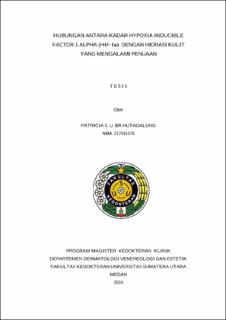Hubungan Antara Kadar Hypoxia Inducible Factor-1 Alpha (HIF-1α) dengan Hidrasi Kulit yang Mengalami Penuaan
Correlation between Hypoxia Inducible Factor-1 Alpha (HIF-1α) Levels with Aging of Skin Hydration

Date
2024Author
Hutagalung, Patricia S U Br
Advisor(s)
Jusuf, Nelva Karmila
Paramita, Deryne Anggia
Metadata
Show full item recordAbstract
Background: Skin aging involves a decline in skin physiological functions influenced by intrinsic and extrinsic factors. One crucial aspect is skin hydration, which affects the skin barrier and water content in the stratum corneum. Hypoxia triggers the activation of hypoxia-inducible factor (HIF-1α), essential for keratinocyte differentiation and maintaining skin barrier function. Reduced HIF-1α expression in the epidermis is associated with decreased skin hydration.
Objective: To determine the correlation between HIF-1α levels and hydration of skin aging.
Subjects and Methods: An observational, cross-sectional study was conducted with 40 participants meeting the inclusion and exclusion criteria. Each subject underwent a detailed history, corneometer examination for hydration assessment, and blood sampling for HIF-1α level measurement via ELISA. Statistical analysis was performed using the Chi-square test, with significance set at p < 0.05.
Results: Based on age, the 40-45 years and 46-50 years groups had the most dry skin hydration values at 35% and 25% respectively, while the 50-55 years age group had the most very dry skin hydration at 12.5%. Among females, 7.5% had good hydration, 50% had dry skin, and 22.5% had very dry skin. HIF-1α levels were low in 90% of subjects and high in 10%, with a mean of 2.76 ng/ml. Statistical analysis revealed a significant correlation between low HIF-1α levels and decreased skin hydration (p = 0.01).
Conclusion: There is a correlation between HIF-1α levels and hydration of skin aging.
